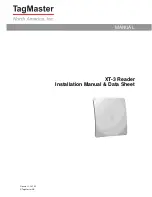
TROLLEY
OPERATION & MAINTENANCE
24
P/N: 11854801 REV. AC
September 2017
OPERATING THE CRANE
Once the crane has successfully passed its Start-up and Pre-
Operational (Initial) inspection, and all the crane operators have been
successfully trained and/or licensed, it is now ready to be placed
into service.
DO NOT OPERATE A CRANE, HOIST OR TROLLEY HAVING
UNUSUAL VIBRATIONS, SOUNDS, WARNINGS OR WITH
ANYTHING WRONG OR APPARENTLY WRONG. DANGER MAY
BE PRESENT THAT THE CRANE OPERATOR CANNOT SEE.
DETERMINE AND CORRECT THE CAUSE OF THE UNUSUAL
CONDITIONS AND MAKE CERTAIN THAT THE CRANE CAN
BE OPERATED SAFELY.
STEP 1.
Turn power on to the crane, disconnects and mainline. If not already
done so, perform Pre-Shift Inspection, refer to the Inspection
Section of this manual.
STEP 2.
Move the crane to the load making certain the load hook is high
enough to clear any obstruction in its path. Position the hoist and
trolley so that the load hook is centered over the load. Lower the
load hook for load attachment. For larger sized loads, the use of a
rigging or load director may need to be used to direct the lift and
movement of the load. This person should use the proper hand
signals as shown in this manual. The crane operator should respond
only the signals of the designated person directing the load, except
for emergency stop as shown on the next page:
OPERATOR HAND
SIGNALS.
PRIOR TO ATTACHING OR LIFTING A LOAD, KNOW THE
WEIGHT OF THE LOAD AND THE BELOW THE HOOK LIFTING
DEVICES (SPREADER OR LIFTING BEAMS, MAGNETS,
GRABS, SLINGS, ETC.). THE TOTAL WEIGHT OF THE LOAD
AND LIFTING DEVICES SHALL NOT EXCEED THE RATED
CAPACITY OF THE HOIST AND/OR CRANE.
STEP 3.
Attach load to load hook. Slowly raise the hook until the slack has
been taken out of the below the hook devices. When the floor man
signals and the operator is satisfied the load is secure in the sling,
lift the load slowly until clear. Now, hoisting speed can be increased
and maintained until the load is clear of all obstructions or the floor
man gives the signal to stop.
STEP 4.
Starting slowly and increasing speed as distance permits, move
the trolley toward the point where the load is to be lowered.
Decelerate and stop by releasing the push button. Final spotting is
accomplished by pressing the button to the first step to creep into
position.
STEP 5.
Learn to judge the stopping distance of the trolley, both with light
and full loads. This will enable you to “spot” loads with the minimum
amount of jogging and excessive load swing.
DO NOT CONTACT OR STRIKE THE HOIST FRAME WITH THE
HOOK BLOCK. IF THE HOIST MOTION IS NOT INTERRUPTED
BY THE LIMIT SWITCH, STOP THE HOIST BY REMOVING
YOUR FINGER FROM THE BUTTON AND/OR DEPRESSING
THE STOP BUTTON. DO NOT ATTEMPT FURTHER
OPERATION UNTIL THE LIMIT SWITCH IS OPERABLE.
CONSULT THE HOIST MANUFACTURER'S INSTRUCTIONS.
NOTICE
JOGGING IS THE RAPID AND REPEATED PRESSING OF
A MOTION PUSHBUTTON (HOIST/TROLLEY) TO GET
THE EQUIPMENT TO MOVE IN SHORT INCREMENTS OR
“INCHING”. ALTHOUGH JOGGING MAY BE NECESSARY
TO POSITION A LOAD, EXCESSIVE JOGGING WILL CAUSE
PREMATURE WEAR AND FAILURE OF MOTORS, BRAKES
AND CONTROLS. IT WILL ALSO CAUSE THE MOTORS
TO QUICKLY OVERHEAT, RESULTING IN THEIR THERMAL
PROTECTION TO DISABLE TROLLEY MOTION UNTIL
COOLED.
THIS EQUIPMENT IS NOT DESIGNED OR SUITABLE AS A
POWER SOURCE FOR LIFTING, LOWERING, OR TRANSPORT
OF PERSONS.
Summary of Contents for Lodeking LT Series
Page 50: ...NOTES ...
Page 51: ...NOTES ...
















































